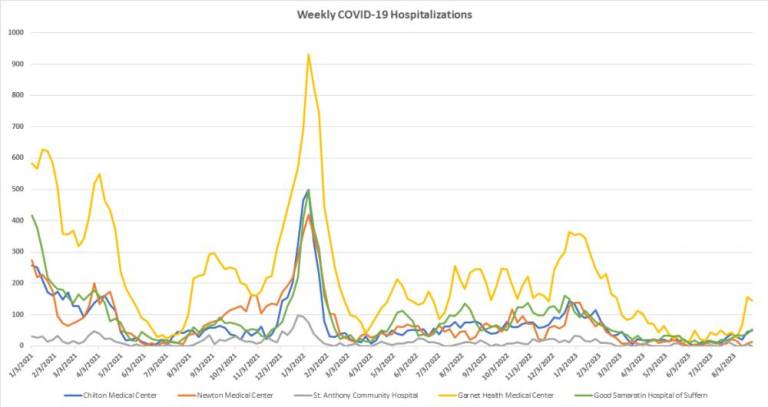A look at local COVID data as updated vaccines arrive
HEALTH. New variants and vaccines arrive as some hospitals see an increase in COVID patients.

As cold and flu season approaches, COVID-19 is on the rise nationwide. The most prevalent variant, EG.5 (nicknamed “Eris”) is a descendent of Omicron and accounts for 24.5 percent of cases.
EG.5 was classified as a “variant of interest” by the World Health Organization, which means it should be monitored closely because of mutations that can make it more contagious.
According to the Centers for Disease Control (CDC), hospitalizations rose 8.7 percent in the United States between Aug. 4 and Sept. 2. But what’s happening locally?
Testing out the data
Local testing does not paint an accurate picture of how many people have COVID-19 because at-home testing kits are now widely available; the U.S. Department of Health only sees data collected from medical facilities.
Test positivity rates, too, are no longer a key indicator of viral spread “because the number of people who test won’t just be dependent on COVID rates, but will be dependent on other things too,” explained Orange County Health Commissioner Dr. Alicia Pointer. “So if we’re more likely to have flu or RSV (respiratory syncytial virus), those are similar symptoms to COVID; you’re going to have a lot more people testing, but maybe the percentages of positive tests will be lower even though the rates may be higher.”
Local hospitalization numbers, however, continue to reflect the severity of COVID-19 in a community. While COVID hospitalizations appear to be on the rise at some area hospitals, the numbers are far from where they were after last year’s holiday season.
The most up-to-date data from the U.S. Department of Health and Human Services shows:
• Garnet Health Medical Center in Middletown, N.Y., had 145 COVID-19 patients the week of Aug. 27 – Sept. 2. This is slightly down from the summer’s highest weekly number of COVID patients, 156, reported the week prior, Aug. 20. This year, Garnet Health saw the most COVID patients the week of Jan. 8, with 359 COVID-positive patients.
• Newton Medical Center, in Newton, N.J., had 14 COVID-19 patients the week of Aug. 27 – Sept. 2. This summer, the facility saw the most cases the week of July 30, with a total of 22 patients. This year, Newton Medical Center saw the most COVID patients the week of Jan. 1, with 138 COVID-positive patients.
• Chilton Medical Center in Pequannock, N.J., had 49 COVID-19 patients the week of Aug. 27 – Sept. 2; the summer’s highest number. This year, the hospital saw the most COVID-19 patients, 133, the week of Jan. 1.
• Good Samaritan Hospital in Suffern, N.Y., had 54 COVID-19 patients the week of Aug. 27 – Sept. 2; the summer’s highest number. This year, the hospital saw the most COVID-positive patients, 113, the week of Jan. 15.
Local long term care facilities see few outbreaks
In recent weeks, most local long term care facilities reported zero weekly cases among residents and staff, with the exception of:
• Wayne Woodlands Manor in Waymart, Pa., had 20 COVID-positive residents and 10 staff members test positive the week of Aug 20. The following week, 14 residents and 14 staff members were reported to have COVID. The facility restricted visitation Aug. 18 – 20, though updated guidance from the Department of Health and Human Services states that visitation must be allowed for all residents at all times.
• Middletown Park Rehab and Health Care Center had 10 residents and 13 staff members test positive the week of Aug. 20. On Aug. 27, there were two newly positive residents and one newly positive staff member.
• Milford Rehabilitation and Healthcare Center in Milford, Pa., and Barn Hill Care and Rehab Center in Newton, N.J., had one COVID-19 positive staff member the week of Aug. 27. Barn Hill Care had one resident test positive the week of Aug 20.
•.Limecrest Subacute and Rehabilitation Center in Sussex, N.J., had one resident and three staff members test positive the week of Aug. 13. Barn Hill Care saw five residents and two staff members test positive the same week.